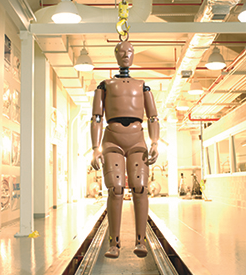Title
The influence of impact interface on human knee injury: implications for instrument panel design and the lower extremity injury criterion
Document Type
Article
Publication Date
11-12-1997
Publication Title
SAE International
Abstract
Injury to the lower extremity during an automotive crash is a significant problem. While the introduction of safety features (i.e. seat belts, air bags) has significantly reduced fatalities, lower extremity injury now occurs more frequently, probably for a variety of reasons. Lower extremity trauma is currently based on a bone fracture criterion derived from human cadaver impact experiments. These impact experiments, conducted in the 1960's and 70's, typically used a rigid impact interface to deliver a blunt insult to the 90° flexed knee. The resulting criterion states that 10 kN is the maximum load allowed at the knee during an automotive crash when certifying new automobiles using anthropomorphic dummies. However, clinical studies suggest that subfracture loading can cause osteochondral microdamage which can progress to a chronic and debilitating joint disease. Additional studies suggest that the stiffness of the impact interface influences knee injury modalities resulting from impact loading. In the current study, a single impact at 27 J of energy with a rigid interface was delivered to one knee of isolated joint preparations of six cadavers resulting in an average peak load of 5 kN. Contralateral knees were impacted with a padded interface at an additional level of energy at approximately the same load. All rigid impact experiments resulted in some form of injury to the patella including occult microcracking and gross fracture of the patella. No injuries were detected in the knees from the padded experiments. Math modeling of the patellae showed significantly reduced tensile and shear stresses in the bone with padding. This study suggests that the current lower extremity injury criterion, based solely on load, may not be sufficiently conservative. Increasing contact area over the knee reduces stresses in the bone and prevents both gross bone fracture and bone and cartilage microdamage. Such data may be useful in future instrument panel designs and might suggest revision to the current lower extremity injury criterion.
DOI
10.4271/973327
ISSN
0148-7191
Rights
©1997 SAE International. All Rights Reserved.
Recommended Citation
Atkinson, Patrick J.; Garcia, Jose J.; Altiero, Nicholas J.; and Haut, Roger C., "The influence of impact interface on human knee injury: implications for instrument panel design and the lower extremity injury criterion" (1997). Crash Safety Center Publications. 38.
https://digitalcommons.kettering.edu/crash_pubs/38



Comments
41st Stapp Car Crash Conference SAE Technical Paper 973327